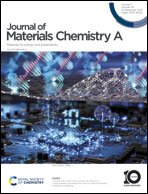Engineering the electronic structure of FeP with rare earth elements to enhance the electrocatalytic hydrogen evolution performance†
Abstract
Modulating metal electrocatalysts by incorporating rare earth (RE) elements has been recently proposed as an effective strategy to improve their catalytic properties. Herein, various RE elements were employed to regulate the electronic structure of an FeP electrocatalyst, and clarify the relationship between RE elements and the electrocatalytic properties for hydrogen generation from experimental and theoretical investigations. Introducing RE elements into FeP regularly tuned the chemical states and electronic structures of FeP to affect intermediate adsorption, with a volcano-like relationship between RE elements and electronic structure as well as electrocatalytic activity for FeP. In particular, cerium as the dopant greatly enhanced the FeP performance, with ultra-small overpotentials of 51 and 100 mV required to drive a 10 mA cm−2 current density as compared with FeP (77 and 155 mV) in acid and alkali, correspondingly. Thus, this work uncovers the influence of RE elements on modulating FeP and suggests the incorporation of RE elements as a novel approach to design highly active electrocatalysts for water electrolysis.



 Please wait while we load your content...
Please wait while we load your content...